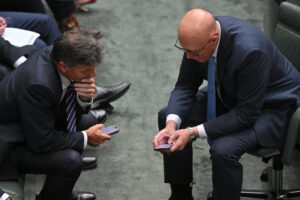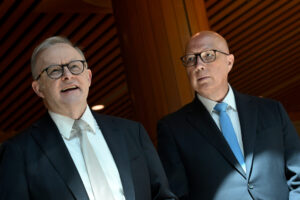Economists are fond of saying that Budgets reveal a government’s priorities and this year’s federal budget reveals the Morrison government’s number one priority is getting re-elected.
In one way, that’s understandable- all governments want to be re-elected. But as the Treasurer’s speech outlined, these are uncertain times. Australia is facing some very real problems like the continuing global pandemic, more frequent and intense climate change-fuelled natural disasters, stagnant wages growth and rising costs of living. Unfortunately, the Treasurer did not deliver a budget that seriously attempted to address serious problems, except the Government’s own political ones.
As my colleague and economist Matt Grudnoff observed, “You would be flattering this budget if you said it was a plan for the next 6 months. Really it is a plan to get through the next 8 weeks to the election.”
After almost a decade in office this election is looking tough, though by no means impossible, for the Coalition. The government is down in the polls and Scott Morrison has been labeled a bully, an autocrat and a liar—and those are just comments from his colleagues. The Labor Opposition has hammered the PM as someone who talks big but fails to deliver. As with all governments, Scott Morrison is finding that the longer you are in office, the more lead you accumulate lead in your saddlebags, sapping the power of incumbency.
Despite this, the advantages of incumbency are still huge with the federal budget chief among them. On Tuesday the Treasurer sought to exercise that power to its fullest: splashing one-off cash handouts, tax breaks and sugar hits designed to help with the cost of living long enough for the government be re-elected.
As with all budgets, the evidence is in the numbers, not political spin. And the numbers reveal the biggest winners are high income earners, fossil fuel companies and Barnaby Joyce.
While there is a welcome temporary $250 cash handout or ‘cost of living supplement’ for those on welfare, there is no permanent increase in income for unemployed people, whom the government expects to live permanently below the poverty line.
Stage 3 income tax cuts will see battlers earning more than $200,000 as some of the biggest winners (they recieve more than $9,000 in permanent tax cuts each year from July 2024, worth $184 billion over 10 years) while those inner-city elitists working on the minimum wage get nothing.
One of the biggest cost of living measures in the budget was the temporary cut to the fuel excise, costing the budget $2.7 billion over six months. At a time when the world is trying to wean itself off fossil fuels, making it cheaper to buy petrol makes no policy sense, even if it makes political sense. This cut to fuel excise delivers the biggest savings to the people who drive the biggest cars and does nothing to encourage fuel efficiency, or help people to switch to electric vehicles, or to help low income earners who can’t afford a car.
The Treasurer offered much needed support for flood-affected communities in New South Wales and southeast Queensland. But the Australian government, closing in on ten years in office, has never undertaken a national risk assessment to understand how vulnerable Australia is to climate change. Nor has it come up with a National Adaptation Plan – so we will just keep lurching from one natural disaster to the next.
The Flood Package includes $245 million in disaster recovery payments to residents in flood-impacted areas, $150 million for significant infrastructure damage, and $150 million for recovery and post-disaster resilience measures in the Northern Rivers region of NSW. These payments are dwarfed by the current damage bill caused by the floods, estimated to be over $6 billion.
The Black Summer Bushfire Recovery Grants Program is receiving $116.4 million in additional funding over three years from 2021-22 to “provide increased support for community projects to assist with recovery and resilience”. This brings the total amount allocated to the program to $500 million. A pittance compared to damage estimates that run up to $100 billion.
Speaking of disasters, the Morrison government continues to prioritise subsidies and tax breaks for coal, gas and oil companies over solutions to climate change. Australia Institute research shows fossil fuel subsidies cost the Federal Government $10.5 billion in 2021-22, an increase of $1.4 billion from 2020-21. This budget contains around $3 billion in additional funding for dirty hydrogen, CCS and gas expansion. More government handouts accelerating greenhouse gas pollution, while communities across Australia dealing with climate disasters are without basic support. While the federal government keeps throwing money at the massive failure that is carbon capture and storage, Lismore was without functional flood sirens when the CBD flooded after the levee was breached again this week.
Lastly, let’s not forget the Budget’s other big winner: constituency of one Barnaby Joyce. The Morrison government committed $5.9 billion for dams without any business case, without any environmental approvals and without any advice from water infrastructure board—the expert body appointed to scrutinise major projects which Joyce abolished a day after the budget.
There is no need for the expert body because the Deputy Prime Minister just wants dams built, damn the costs and damn the experts. “We’re not asking for a return, so we’re not really interested in the business case,” Mr Joyce told reporters.
It is in crises that the mettle of leaders is really tested, one only needs to look at Ukrainian President Volodymyr Zelenskyy, who addressed the Australian parliament this week to see that. Between the Black Summer bushfires, global pandemic, and disastrous floods, Scott Morrison has faced many leadership-defining crises himself and voters will soon judge his leadership on those. Sadly, this week’s Budget shows the Prime Minister is more interested in solving his own political crises than those faced by Australians.
Between the Lines Newsletter
The biggest stories and the best analysis from the team at the Australia Institute, delivered to your inbox every fortnight.
You might also like
Business groups want the government to overhaul the tax system? Excellent – we have some ideas.
The landslide win by the ALP has seen business groups come out demanding the government listen to their demands despite having provided them no support, and plenty of opposition, over the past 3 years.
The Liberal Party defies its own history on tax
For decades, the Liberal Party has prided itself on being the “party of lower taxes”.
5 ways and 63 billion reasons to improve Australia’s tax system
With a federal election just around the corner, new analysis from The Australia Institute reveals 63 billion reasons why our next Parliament should improve the nation’s tax system.


